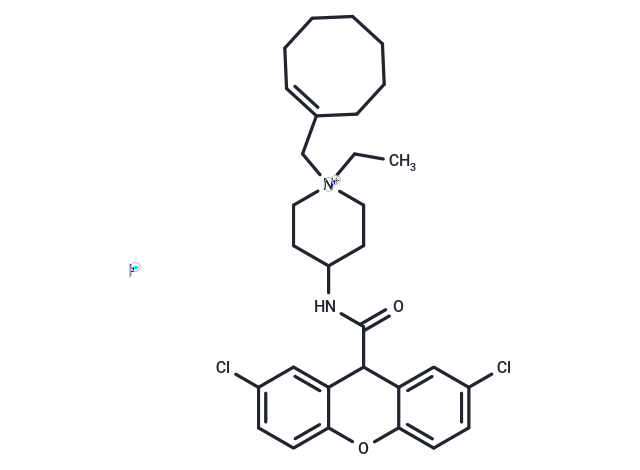Shopping Cart
Remove All Your shopping cart is currently empty
Your shopping cart is currently empty
J-113863 is also a potent antagonist of the human CCR3 (IC50 of 0.58 nM) , but a weak antagonist of the mouse CCR3 (IC50 of 460 nM). J-113863 is inactive against CCR2, CCR4 and CCR5, as well as the LTB4 or TNF-α receptors. Anti-inflammatory effect. J-113863 is a potent and selective CCR1 (CD18) antagonist with IC50 values of 0.9 nM and 5.8 nM for human and mouse CCR1 receptors, respectively.

| Pack Size | Price | USA Warehouse | Global Warehouse | Quantity |
|---|---|---|---|---|
| 1 mg | $54 | In Stock | In Stock | |
| 2 mg | $79 | In Stock | In Stock | |
| 5 mg | $128 | In Stock | In Stock | |
| 10 mg | $172 | In Stock | In Stock | |
| 25 mg | $319 | In Stock | In Stock | |
| 50 mg | $555 | In Stock | In Stock | |
| 100 mg | $798 | In Stock | In Stock | |
| 1 mL x 10 mM (in DMSO) | $189 | In Stock | In Stock |
| Description | J-113863 is also a potent antagonist of the human CCR3 (IC50 of 0.58 nM) , but a weak antagonist of the mouse CCR3 (IC50 of 460 nM). J-113863 is inactive against CCR2, CCR4 and CCR5, as well as the LTB4 or TNF-α receptors. Anti-inflammatory effect. J-113863 is a potent and selective CCR1 (CD18) antagonist with IC50 values of 0.9 nM and 5.8 nM for human and mouse CCR1 receptors, respectively. |
| Targets&IC50 | CCR3:460 nM (IC50, Mouse CCR3), CCR1:5.8 nM (IC50, Mouse CCR1), CCR1:0.9 nM (IC50, Human CCR1), CCR3:0.58 nM (IC50, Human CCR3) |
| In vitro | The chemotaxis of the following cells were inhibited by J-113863. Modified Vaccinia virus Ankara (MVA) but not MVA and vaccinia virus (VACV) infected MH-S cells increase the expression of the CXCR2 acting chemokine CXCL2. MH-S cells constitutively produce CCL2 and CCR1 acting chemokines CCL3, CCL5 and CCL9. Consequently, supernatants of mock treated and virus infected MH-S cells induce chemotaxis of murine promyelocyte MPRO cells and human monocytic THP-1 cells at the same level. However, supernatants of MVA infected MH-S cells significantly increase chemotaxis of the CCR2 deficient human monocytic cell line U-937. |
| In vivo | J-113863 treatment improves paw inflammation and joint damage, and dramatically decreases cell infiltration into joints in arthritic mice. |
| Molecular Weight | 655.44 |
| Formula | C30H37Cl2IN2O2 |
| Cas No. | 353791-85-2 |
| Smiles | [I-].CC[N+]1(C\C2=C\CCCCCC2)CCC(CC1)NC(=O)C1c2cc(Cl)ccc2Oc2ccc(Cl)cc12 |
| Relative Density. | no data available |
| Storage | Powder: -20°C for 3 years | In solvent: -80°C for 1 year | Shipping with blue ice/Shipping at ambient temperature. | ||||||||||||||||||||
| Solubility Information | DMSO: 6.56 mg/mL (10.01 mM), Sonication is recommended. | ||||||||||||||||||||
| In Vivo Formulation | 10% DMSO+40% PEG300+5% Tween 80+45% Saline: 1 mg/mL (1.53 mM), Sonication is recommended. Please add the solvents sequentially, clarifying the solution as much as possible before adding the next one. Dissolve by heating and/or sonication if necessary. Working solution is recommended to be prepared and used immediately. The formulation provided above is for reference purposes only. In vivo formulations may vary and should be modified based on specific experimental conditions. | ||||||||||||||||||||
Solution Preparation Table | |||||||||||||||||||||
DMSO
| |||||||||||||||||||||
| Size | Quantity | Unit Price | Amount | Operation |
|---|

Copyright © 2015-2025 TargetMol Chemicals Inc. All Rights Reserved.